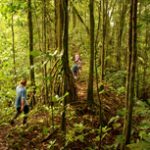Unique nature
São Tomé is 50 kilometers (31 miles) long and 32 kilometers (20 miles) wide and the more mountainous of the two islands. Its highest peak reaches 2,024 meters (6,640 feet). Príncipe is approximately 30 kilometers (19 miles) long and 6 kilometers (4 miles) wide. Its highest peak reaches 948 meters ( 3,110 feet). In addition to being the second smallest African country, it is also the smallest Portuguese speaking country.
The islands of São Tomé and Príncipe are situated in the Atlantic Ocean about 300 and 250 kilometers (200 and 150 miles), respectively, off the northwest coast of Gabon. Both islands, also known as Guinea Islands, lie on an alignment of once-active volcanoes. The equator lies immediately south of São Tomé.
The geographic isolation from Africa has resulted in high levels of endemism, notably among plants (130 species) and birds (28 species). Overall, Sao Tome and Principe has 895 species of plants, 143 birds, 15 mammals, 14 reptiles, and 9 amphibians.
About 28 percent of the country is forested, of which 44 percent is classified as primary forest. Most of this remaining forest is found in the most inaccessible parts of the country. There are over 150 type of tree ferns on the islands, more than anywhere else in Africa. Also, coconut palms reach down to the fringes of the beaches, almond trees and bread fruit trees line the town streets, and banana, cocoa and sugar cane plantations are plentiful.
Orchids are the most important among the spontaneous plants on the islands. Up to now, 129 orchid species have been identified: 101 on Sao Tome, and 64 on Principe. The rainy season is the best time for orchid spotting, but species above 800m are still in flower in January.
Source: Bradt Travel Guide São Tomé & Príncipe, July 2008
Cultural history
São Tomé and Príncipe is a place with a rich cultural heritage where people are happy to meet you. The lack of tribal, ethnic or religious conflict adds to the friendly “leve leve” (as the locals say, “easy-easy”) atmosphere.
The human history on Sao Tome & Principe begins in 1470, when the Portuguese settlers came to the islands. No evidence is available that African settlers were there before that time, although this is likely.
Slaves from Creole descent where put to work in the sugar cane fields towards the end of the 15th century, who where freed approximately 20 years later. Their work and living conditions did not change much, however, until much later.
Sugar cultivation declined over the years, and by the mid-1600s, São Tomé was little more than a port of call for bunkering ships. In the early 1800s, two new cash crops, coffee and cocoa, were introduced. The rich volcanic soils proved well suited to the new cash crop industry, and soon extensive plantations (rocas), owned by Portuguese companies or absentee landlords, occupied almost all of the good farmland. By 1908, São Tomé had become the world’s largest producer of cocoa, still the country’s most important crop.
The rocas system, which gave the plantation managers a high degree of authority, led to abuses against the African farm workers. Although Portugal officially abolished slavery in 1875, the practice of forced paid labour continued.
After a period of transitional government, São Tomé and Principe achieved independence on July 12, 1975.
Cape Verdeans form the largest group of foreigners, perhaps amounting to about 10 percent of the total population; many have adopted São Tomense nationality.
Portuguese, Angolans, and Mozambicans make up most of the rest of the foreign community. Like the Cape Verdeans, they are relatively well integrated with the other islanders, owing to a shared Portuguese cultural background. The Angolares, descended from slaves who survived a shipwreck in the 16th century, remained apart in the isolated southern zone of São Tomé island until the late 19th century, speaking a Bantu language. They have since spread throughout the country and have become largely assimilated.
Almost the entire population belongs to the Roman Catholic church, although there are a few small Protestant congregations. Traditional African religions are also practiced.
Portuguese is the official language and is understood by a majority of islanders.

